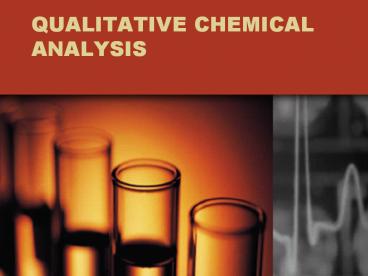QUALITATIVE CHEMICAL ANALYSIS - PowerPoint PPT Presentation
1 / 9
Title:
QUALITATIVE CHEMICAL ANALYSIS
Description:
Qualitative vs. Quantitative A qualitative characteristic is a description of something that does not involve numbers or units of measurement. – PowerPoint PPT presentation
Number of Views:178
Avg rating:3.0/5.0
Title: QUALITATIVE CHEMICAL ANALYSIS
1
QUALITATIVE CHEMICAL ANALYSIS
2
Qualitative vs. Quantitative
- A qualitative characteristic is a description of
something that does not involve numbers or units
of measurement. - If number and units are used then we are using a
quantitative method of describing the object. - How could you describe a fire truck both
qualitatively and quantitatively? - How could you describe a substance both
qualitatively and quantitatively?
3
CHEMISTRY CSI
- You can use the solubility rules to determine the
presence of certain ions in a solution by
conducting double displacement reactions. - All you need to do is mix your water sample that
contains the suspected ion with a solution that
contains the ions that form a precipitate with
your suspect ion.
4
EXAMPLE 1
- Lets say you suspect your water sample has
acetate in it. What could you do? - If you combine your water sample with a solution
that contains silver ions (Ag) then you can
detect the presence of acetate because silver
acetate will form which is insoluble meaning it
will form a precipitate. - Ag(aq) C2H3O2-(aq) ? AgC2H3O2 (s)
5
THE BIG PROBLEM
- The major issue that has to be dealt with is that
most solutions or samples contain more than one
type of ion so chemists must design test
procedures to identify and remove any suspected
ions one at a time - You need to find a solution that will react (form
a precipitate) with only one of the ions at a
time.
6
EXAMPLE 2
- Lets say we suspect a solution has both iron
(Fe2) and strontium (Sr2) ions in it. - Solubility rules say that hydroxide ions (OH-)
will react with the iron ions (Fe2) and form a
precipitate but will not have the same reaction
with strontium ions. - So we can simply add a solution of sodium
hydroxide (NaOH). This will dissociate and the
hydroxide ions (OH-) will form a precipitate with
the iron ions (Fe2) in the solution. - Fe2(aq) OH-(aq) ? Fe(OH)2(s)
7
EXAMPLE 2Part 2
- To remove the iron out of the solution we will
centrifuge the solution with the precipitate. The
rapid spinning will force the more dense
precipitate to the bottom of the test tube and
the liquid with the strontium ions in it will
remain on top. - The solution containing the strontium ions is
called the supernate. We keep this for further
testing.
8
EXAMPLE 2Part 3
- Now we have the supernate with the strontium ions
in ithow do we test for the strontium ions? - Sulfates (SO42-) will form precipitates with
strontiumso we need to add an aqueous solution
that contains sulfate ionslike sodium sulfate
(Na2SO4). - The precipitate that forms will contain the
precipitate called strontium sulfate. - Sr2(aq) SO42-(aq) ? SrSO4 (s)
9
Thats All I Got































